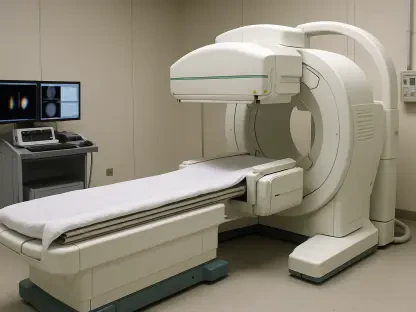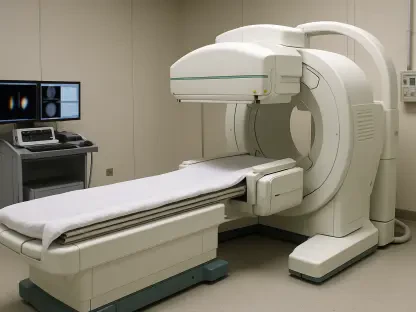In an era where the volume of medical knowledge doubles at a staggering rate, artificial intelligence (AI) is stepping into the healthcare arena as a transformative force, poised to redefine how clinicians make critical decisions at the bedside and improve patient outcomes. These innovative tools, often likened to the portable ultrasound devices that revolutionized diagnostics decades ago, are designed to provide rapid, evidence-based insights directly at the point of care, addressing the urgent need for efficiency in high-stakes environments. As physicians grapple with information overload and time constraints, AI clinical decision-support systems emerge as indispensable additions to the traditional toolkit, promising to enhance accuracy and patient outcomes. Yet, this technological leap forward brings with it a complex set of challenges, particularly around trust, reliability, and the preservation of the human connection in medicine. Navigating this landscape requires a careful balance of innovation and oversight to ensure that patient safety remains paramount.
Addressing the Information Overload in Healthcare
The sheer volume of medical literature published daily presents an insurmountable challenge for clinicians striving to stay current while managing demanding schedules. With new research and guidelines emerging constantly, the ability to access relevant, trustworthy information at the point of care has become a critical need. AI tools are uniquely positioned to tackle this issue by curating vast datasets into concise, evidence-based summaries that can be accessed in real-time. This capability allows doctors to make informed decisions without the burden of manually sifting through dense resources during critical moments. By streamlining access to vital knowledge, AI not only boosts efficiency but also reduces the risk of oversight in fast-paced clinical settings, ensuring that patient care is grounded in the most up-to-date information available.
Beyond simply providing data, AI systems are evolving to prioritize relevance and context, tailoring insights to the specific needs of each case. This personalized approach means that clinicians receive recommendations aligned with individual patient profiles, cutting through the noise of irrelevant or outdated studies. Such precision is a game-changer in environments where every second counts, enabling healthcare providers to focus on diagnosis and treatment rather than research. Moreover, this technology builds on the legacy of past innovations that enhanced diagnostic capabilities, proving that well-designed tools can significantly elevate the standard of care. As these systems continue to refine their algorithms, their potential to alleviate cognitive overload for medical professionals becomes increasingly evident, paving the way for smarter, more effective practice.
Ensuring Trust in AI-Driven Medical Tools
Trust forms the foundation of any technology adopted in healthcare, where the stakes are often life and death. Clinicians and patients must have unwavering confidence in AI tools, knowing that their recommendations are based on accurate, reliable data. A significant concern arises with general-purpose AI models that pull from unverified internet sources, often blending factual content with speculation or misinformation. Such inconsistencies can lead to catastrophic errors in clinical decision-making, underscoring the necessity for specialized AI systems trained exclusively on vetted, evidence-based medical information. Addressing these risks is essential to fostering trust among healthcare providers who rely on these tools to support critical judgments under pressure.
Equally important is the transparency of AI processes, which allows clinicians to understand and validate the reasoning behind each recommendation. When the logic driving a suggestion is clear, medical professionals can confidently integrate AI insights into their practice, ensuring that technology complements rather than undermines their expertise. This trust is further reinforced by continuous evaluation and feedback loops that refine AI accuracy over time, adapting to the evolving landscape of medical knowledge. By prioritizing reliability and clarity, developers can mitigate skepticism and build a foundation of confidence that encourages widespread adoption. Ultimately, trust in AI is not just about technical performance but about aligning with the ethical standards that define patient care, ensuring that every decision prioritizes safety and well-being.
Implementing Guardrails for Responsible AI Use
To establish AI as a dependable partner in healthcare, robust guidelines must be in place to safeguard its application. A primary focus is ensuring that AI models are trained solely on credible, evidence-based datasets, free from the clutter of unverified online content. Transparency in how these tools generate recommendations is equally critical, as it empowers clinicians to scrutinize and verify the underlying logic, reinforcing confidence in the technology. These measures prevent the dissemination of misleading information and protect against errors that could jeopardize patient outcomes. By setting strict standards for data integrity and openness, the healthcare industry can mitigate risks and create a framework where AI serves as a reliable aid in complex decision-making processes.
Another vital component of responsible AI implementation is maintaining human oversight at every stage. AI must function as a supportive tool rather than an autonomous decision-maker, integrated into clinical workflows with continuous input from medical experts. This “human-in-the-loop” approach ensures that nuanced cases, which often require emotional intelligence and contextual understanding, are handled with the care and judgment only humans can provide. Such collaboration not only prevents over-reliance on technology but also preserves the ethical core of medicine, where patient well-being remains the ultimate priority. Through these guardrails, AI can enhance clinical practice without compromising the trust and accountability that define the profession, fostering a balanced partnership between innovation and expertise.
Integrating AI Seamlessly into Clinical Practice
For AI to truly transform healthcare, it must integrate effortlessly into the daily routines of clinicians without adding complexity or disruption. Thoughtful design plays a pivotal role in making these tools intuitive, ensuring that doctors can access critical insights without diverting attention from patient interactions. When AI systems are user-friendly and aligned with existing workflows, they become a natural extension of a physician’s toolkit, enhancing rather than hindering productivity. This seamless incorporation is crucial in busy environments where time is a scarce resource, allowing healthcare providers to maintain focus on delivering high-quality care while leveraging technological support for efficiency.
Furthermore, successful integration involves customizing AI tools to meet the diverse needs of different medical specialties and settings. A one-size-fits-all approach falls short in a field as varied as healthcare, where workflows and priorities differ significantly between, say, emergency rooms and outpatient clinics. By tailoring functionalities to specific contexts, AI can address unique challenges, such as rapid diagnostics in urgent care or detailed record analysis in chronic disease management. This adaptability not only improves usability but also maximizes the technology’s impact on patient outcomes. As developers refine these systems to blend into clinical environments, the potential for AI to streamline operations and reduce administrative burdens becomes increasingly tangible, setting a new standard for medical practice.
Reviving Human Connection Through AI
One of the most profound yet unexpected benefits of AI in healthcare is its capacity to restore the personal touch that has often been eroded by systemic pressures. As administrative tasks and time constraints have transformed patient encounters into brief, transactional exchanges, clinicians struggle to build meaningful relationships with those in their care. AI offers a solution by automating repetitive duties such as documentation and data retrieval, freeing up valuable time for doctors to engage with patients on a deeper level. This shift enables healthcare providers to truly listen, understand individual concerns, and tailor treatments to unique needs, fostering a sense of empathy and trust that lies at the heart of effective care.
Additionally, by alleviating the cognitive and logistical burdens that weigh on clinicians, AI helps reduce burnout, a pervasive issue in the medical field. When physicians have the bandwidth to focus on human interaction rather than paperwork, they can approach each case with renewed energy and compassion. This not only benefits patients, who feel seen and valued, but also enhances job satisfaction among healthcare professionals, creating a virtuous cycle of improved care delivery. The potential for AI to rehumanize medicine is a compelling argument for its adoption, provided it is implemented with sensitivity to the emotional and ethical dimensions of healing. As technology takes on the mundane, it paves the way for a return to patient-centered practice, where connection and understanding take precedence.
Navigating the Ethical Landscape of AI Innovation
The growing acceptance of AI as a solution to healthcare’s systemic challenges reflects a broader trend toward technology-driven progress, but it also raises significant ethical considerations. There is widespread agreement that while AI can enhance efficiency and decision-making, unchecked adoption of unverified tools poses substantial risks to patient safety. Striking a balance between embracing innovation and upholding rigorous standards is paramount, ensuring that AI complements rather than competes with human expertise. This cautious approach acknowledges the transformative potential of technology while prioritizing the principles of accuracy, transparency, and accountability that underpin medical ethics, safeguarding trust in the system.
Looking ahead, the path forward involves continuous dialogue among stakeholders—clinicians, developers, policymakers, and patients—to shape the ethical framework for AI in healthcare. Establishing clear regulations and best practices will be essential to prevent misuse and ensure that technology serves the greater good. Collaborative efforts to monitor and refine AI applications can help address emerging challenges, adapting to new risks as they arise. By fostering an environment of shared responsibility, the industry can harness the benefits of AI while mitigating its pitfalls, ultimately advancing a vision of healthcare that is both innovative and deeply rooted in patient welfare. This balanced perspective, forged through past efforts, offers a roadmap for sustainable progress.









